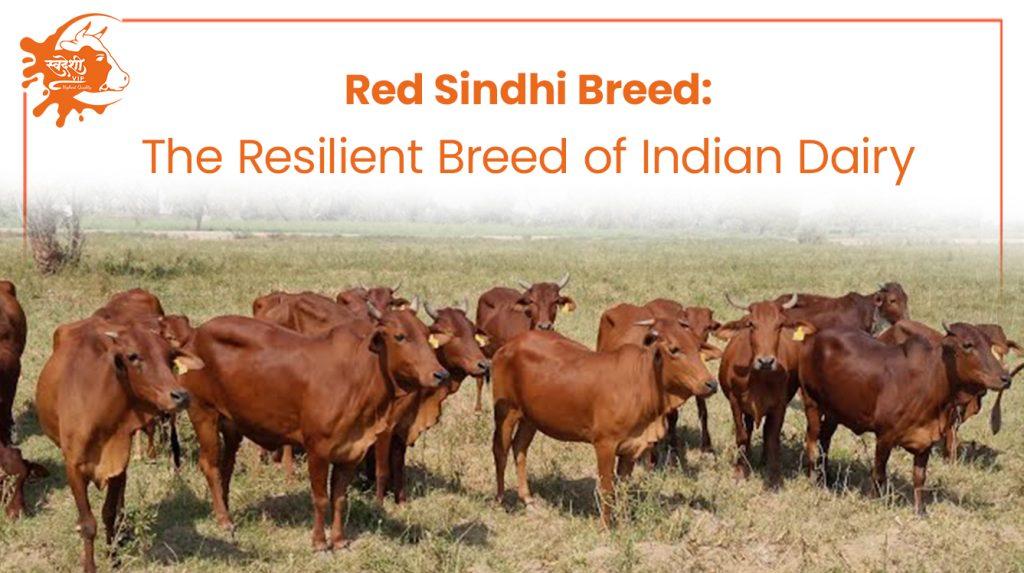
Red Sindhi Breed is one of the prominent Indian cow breeds. Cattle in India have been traditionally raised for milk and labour purposes since old age times. The dairy industry in India is vital for both rural and urban economies, providing livelihoods for millions of small and marginalised farmers and ensuring food stability by supplying necessary nutrition to the country’s rising population.
India is the world’s largest milk producer; milk production of India is estimated to reach 236.35 million tonnes in 2023-24, registering a growth of 2.5% over the last year, beating the world average growth rate.
The dairy market in India plays a vital role in meeting the protein and calcium needs of the population by delivering milk and dairy products, which are essential parts of the Indian diet. Simultaneously, this sector in India ensures the accessibility of critical nutrients for the physical and mental development of the population.
This indigenous Red Sindhi breed is known for its high genetic potential for milk production and is primarily maintained; due to its toughness, vigour, heat resistance, and high milk yields, this breed has gained the spotlight PAN India and globally.
The Red Sindhi breed originated in Sindhi, Pakistan. They are known for their hardiness, heat resistance, and high milk yields; they have spread to many parts of India and in at least 33 countries across Asia, Africa, Oceania, Africa, Australia, the Philippines, Tanzania, Sri Lanka, Iraq, and the Americas.
The breed has different other names such as “Malir”, “Red Karachi”, and “Sindhi”. The Red Sindhi breed is believed to have originated from the Las Bela cattle found in Bela, in Baluchistan. However, several organised herds from this breed are maintained at government farms.
The Red Sindhi breed usually has very high genetic potential for milk production and can be comparable with Sahiwal. In India, the animals of this breed are not likely available in field conditions.
Red Sindhi cows were brought to Brazil in the middle of the 20th century. These cows were used for milk production in Brazil but were not as popular as other breeds.
At present, the breed can be found all over the world and is raised for both meat and milk production. The breed originally came from Hyderabad, Bikaner, and Pakistan, India. They have been used for crossbreeding with other cattle breeds from cold climates in many countries, merging their ability to thrive in tropical conditions (disease resistance, fertility in higher temperatures, etc.) with the higher milk production of temperate regions.
Red Sindhi breed cows are hardy and highly resistant to heat and ticks. They are the most economical milk producers among India’s dairy breeds.
The Red Sindhi breed is known for its resilience, adaptability, and productivity in various climates and environments. It’s an asset to the global livestock industry with high milk yield, heat and tick resistance, and successful crossbreeding for improved traits.
This breed thrives in adverse conditions, resulting in a high calf survival rate. Crossbreeding with European dairy breeds has combined its tropical adaptations and disease resistance with increased milk production in temperate regions.
The Red Sindhi’s adaptability to hot and humid climates and resistance to common cattle diseases make it suitable for milk and beef production and draught purposes like ploughing fields or hauling carts.
Red Sindhi cows must be fed a balanced, nutritious diet rich in protein, energy, and minerals.
Red Sindhi cows need proper grazing and are provided with good quality pastures that are rich in nutrients and can help raise their milk production.
Practising milking is essential to ensure that the milk produced by Red Sindhi cows is of good quality.
Daily veterinary care is essential to confirm that Red Sindhi cows are healthy and free from diseases affecting milk production.
In an agriculture-based developing country like India, natural resources provide primary livelihood to the rural people. Rural families rely on land, water, livestock, and forests to create employment and earn their livelihood. The livestock covers cattle, and buffaloes play a significant role. Under good management conditions, the Red Sindhi modes over 1700 kg of milk per lactation after suckling their calves, but there have been milk yields of over 3400 kilograms under optimum conditions.
The average milk production of this breed in India varies between 1300 kg to 1800 kg per lactation. The Red Sindhi Breed is one of the best milch breeds of the subcontinent. This breed is mainly found in the Hyderabad and Karachi districts of Pakistan; cows in this breed are kept in almost all parts of the country for milk production.
This is thought to have originated in western Sindh and the Las Bela region of Balochistan, which is now part of Pakistan.
This breed has a distinct red colour, notably darker than Sahiwal. Some have small white patches in the dewlap and forehead. The horns are thick at the base, emerge laterally, and curve upward.
The reported milk production varies from 1188 to 1675kg in 270 days, or 4.5-6 kg daily.
Gir cows are considered the highest-milk-producing breed in India. This breed can produce 50-80 litres of milk in a day.
No, Red Sindhi are indigenous breeds. Exotic breeds belong abroad, while indigenous cattle belong to the natives of our region.
Red Sindhi cows’ cost around Rs. 52,000.
Red Sindhi is a cow, a heat-tolerant milch cattle breed from Pakistan’s Sindh province.
The red Sindhi breed is prominent in Sindh Pradesh, Pakistan, and the states of Orissa, Bengal, Bihar, Jharkhand, Rajasthan, and Punjab in India.
The Red Sindhi is among the numerous Zebu cattle breeds in India and Pakistan. This breed has developed a higher inherent milk–producing ability than other Zebu cows.
